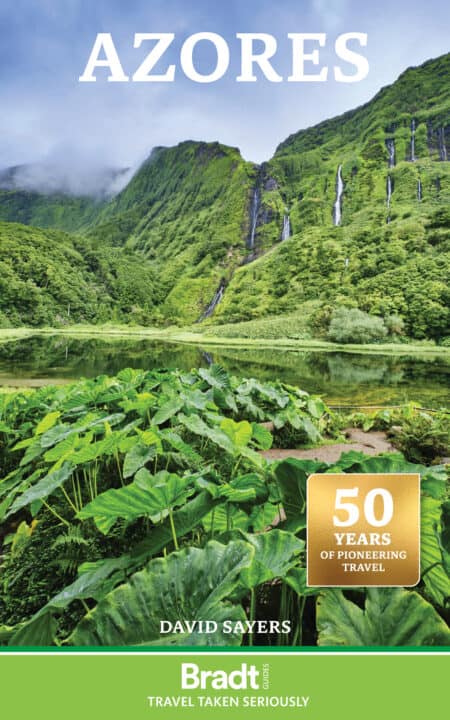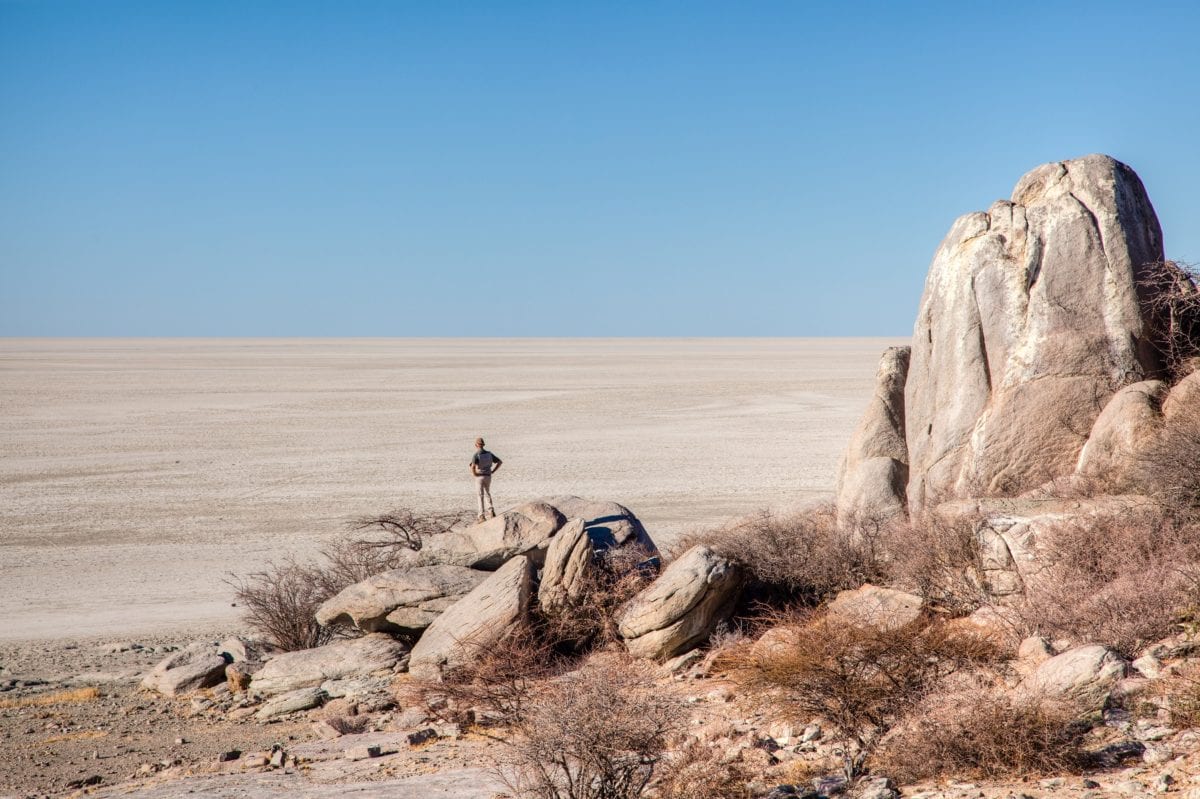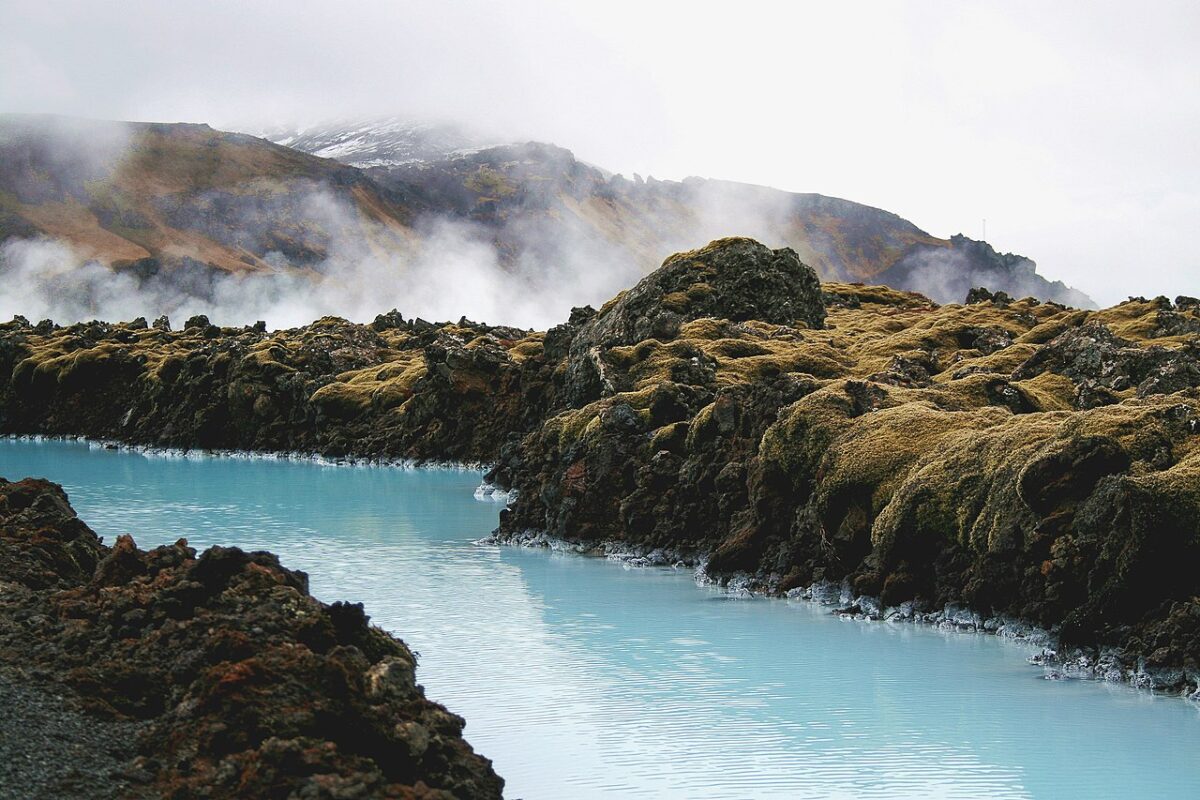One needs to take the Azores at their own speed. Fight it, and you will be frustrated; relax along with it and you will return a different person. Old-world courtesy prevails, a reminder of the many tiny niceties of life that have been sacrificed to the exigencies of faster lifestyles.
Murray Stewart, author of Azores: The Bradt Guide
First settled in the 15th century, the Azores archipelago rises out of the vast North Atlantic:tranquil, green and welcoming. Recently the islands of Corvo, Flores and Graciosa have been declared UNESCO Biosphere Reserves, while the town of Angra do Heroísmo on Terceira and the vineyards of Pico are World-Heritage listed. But the nine islands are best known for their natural landscapes: areas of dense evergreen forest that once covered much of the islands; lush agricultural land with burgeoning hedgerows; and spectacular volcanic landscapes, including the twin lakes of the Sete Cidades, on São Miguel.
The Azores are not a beach or nightlife destination, but are perfect for holidays taking glorious walks, studying volcanoes, enjoying wildflowers and birds, finding little village restaurants serving freshly caught fish, exploring the old towns with their cobbled streets and patterned pavements, and enjoying island wines in the many cafés and bars. For those seeking a more adventurous holiday, there are some of the world’s best whale-watching trips to do, or you can go sea kayaking, canyoning, wind surfing, diving, swimming, horseriding, and perfect routes for cycling. Whatever your interest, the Azores have an old-world charm and dignity that never fails to impress those happy to accept their values and slower pace of life.
For more information, check out our guide to the Azores:
Food and drink in the Azores
Eating
Eating out in the Azores can be a very variable experience. The true positive is the quality of the meat and the fish, which is first-class. Usually, these dishes are simply prepared, and a rich accompanying sauce would be a rare find. Sometimes you can strike it lucky in the more expensive eateries and be given a sophisticated and well-presented dish, depending on who is cooking that night. Many Azoreans admit that there is often a focus on quantity rather than sophistication and you will surely never be underfed here. Most islands have one or two stand-out restaurants (though not really ‘top-end’ by European or North American standards), raising the level or doing something a bit inventive or different. Azoreans have fairly conservative tastes, which results in the appearance of boiled potatoes or chips with many meals. Often, meals will be served with potatoes and rice, plus a huge basket of bread to accompany it: for many, far too much carbohydrate. Vegetarians will have to look hard for variety, though Ponta Delgada has one excellent meat-free restaurant and more and more restaurants and larger hotels usually have some vegetarian options, too. One peculiarity is that many of the places calling themselves ‘snack-bars’ are in fact almost indistinguishable from many middle-of-the-road restaurants.
Sadly it cannot truthfully be claimed that the islands are a gastronomic delight, but this is changing, albeit slowly. The lower- and mid-priced restaurants often seem to share the same menu so that after a week you are hunting for novelties. To find these is easier in Angra, Ponta Delgada and Horta, where there are more restaurants to choose from. With such a good growing climate there should be a wonderful range of vegetables on offer but it seems most townspeople prefer simply to buy from the supermarket rather than grow much for themselves, and the supermarkets are not very adventurous. This is then reflected in the restaurants, which is no excuse, however, for serving rice and chips in combination, together with tinned diced mixed vegetables. Salads are mostly lettuce, some tomato, sliced onion, maybe grated carrot and if you are lucky, some cucumber, rarely all together; dressing is usually left to you, from a bottle of olive oil and vinegar. Hotels often offer more variety, and can be very good, but even the best can include some of the routine ingredients cooked unimaginatively.
Portions are generally huge, sometimes overpoweringly so, especially meat. Fish, including seafood, is usually excellent, best eaten plain grilled or else as a local version of bouillabaisse; the alcatra on Terceira is an excellent example, though often this is made with meat instead. Bacalhau (dried cod), the traditional village dishes and Azorean sausages can be very good indeed, as can the spicy chouriço (smoked sausage) and the black blood sausage, morcelas, with pineapple, but not too often in the same week!
Mercifully, Azorean cheeses are good and quality mainland Portuguese wines have been unsung for far too long, leaving the diner feeling very content with the world. Some chocolate desserts can be gorgeous.
Drinking
The settlers in the Azores had their priorities well ordered because wine has been produced since the very early days. On Pico grape varieties brought by the first settlers from mainland Portugal failed to acclimatise. The Verdelho grape was imported around 1500, possibly from Sicily, or maybe from Madeira, or perhaps by a Jesuit from Italy.
Vines were first planted on a large scale in the 16th century by the Catholic orders of Franciscans and Carmelites and by Jesuits in the following century. On Pico the vines were brought to Silveira, but here the surrounding land was too good for grapes and needed for essential foods such as wheat. Instead they went to the geologically youngest area of the island where the ground was very poor and stony, around the west coast.
It is so heavily lava-strewn that it was only with great labour and difficulty sufficient stones were cleared, using them to make what became the characteristic walls, or currais, of small enclosures that provide such wonderful shelter from salty winds and at the same time extra heat. Surplus stone was neatly stacked into rectangular piles called richeiros.
This was done mainly along the western edge of the island and now, almost half a millennium later, it is a protected zone because of its history. Other interesting features of this extraordinary memorial to the energy and persistence of the islanders include the decansadouros, the resting places for those carrying full baskets of grapes; made of stone, they are in two levels, one for those carrying on their heads and those carrying baskets on their shoulders. At the height of production some 30,000 barrels or 15 million litres were produced annually.
Among the countries it was exported to were Britain and famously to the Russian tsars, apparently by a German trading family. Quite what this wine was is not known as there were very few written records kept about how it was produced. However, Edward Boid, visiting in 1832, wrote that the merchants in Horta took the Pico wine and mixed it with wine from São Jorge and added brandy.
It was then heated to between 110˚F and 130˚F for four to six months, during which time any evaporation from the casks was topped up with more wine and brandy. It seems that different blends were produced for different markets.
Because of the rocky terrain, transport of the barrels was difficult, and to get them onto the waiting ships, wooden boards were laid over rocks that had previously been cut and roughly levelled. You might see old stone slipways or rola-pipas used to get the barrels into the sea, where they were then towed out to the waiting ship. The best Pico wine was said to be ‘so good it should be drunk in the middle of a prayer’.
When disease struck in the mid 1800s the first vines were replaced with the hardy Isabella grape whose strong aroma gave rise to the vinho de cheiro – fragrant wine. This is widely made throughout the islands for village consumption, and many a walker has staggered onward under the influence of spontaneous hospitality.
Twenty years or so ago small-scale experiments were conducted with new continental varieties, and some old stone enclosures replaced by long, straight rows supported by wires that always looked impressively immaculate in their level fields of cinders. However, it is the traditional method with its long history that is the remarkable showpiece and has most recently been rejuvenated in a number of ways, firstly by recognising various areas of vine growing and production – the Zonas Vitivinícolas – and secondly by the establishment of a Regional Commission based in Madalena to guarantee quality and production methods, and certification.
Named quality wines produced in a demarcated area are designated VLQPRD (vinhos licorosos de qualidade produzidos em região determinada), which covers vinhos licorosos or fortified sweetened wines recommended as an aperitivo, and includes the white table wine Pedras Brancas from Graciosa, now happily much reduced in price from a few years ago. The VLQPRD include the Brum wine from Biscoitos on Terceira and Pico’s Lajido.
Health and safety in the Azores
Health
All EU nationals visiting the Azores are entitled to the reciprocal arrangements covering medical care and expenses but will need the appropriate documentation. Dental treatment will mostly have to be paid for. British nationals should have their European Health Insurance Card (EHIC), obtainable online or from the post office and some travel clinics. The validity of this card for British nationals may be in doubt once the UK exits from the EU. You should in any case have additional private travel insurance. Pregnant women, travellers with pre-existing illnesses and those travelling with children or going to remote areas should identify healthcare facilities prior to departure. However, larger hotels and tour company representatives are usually able to provide addresses for local services. The Foreign and Commonwealth Office can provide details of the nearest relevant embassy or consulate for emergencies.
Hospitals in the Azores are modern and equivalent to normal European standards. They are located on São Miguel, Terceira and Faial. On certain islands where there are limited services, emergency medical cases have to be flown either to Faial or Terceira. Health centres (centros médicos) provide non-hospital treatment.
Pharmacies are widespread, but you should always take a sufficient supply of prescription drugs to more than last the length of your holiday. When travelling, do not pack them all in your suitcase; always make sure you have enough tablets and any medical equipment you use regularly in your hand luggage. The pharmacies in larger towns will have a rota for out-of-business-hours opening; if you need anything, ask at your hotel or a police station to see which one is open.
Tap water in the hotels is generally safe to drink; on some islands it tastes better than some bottled waters. However, if you are in any doubt then drink bottled or treated water (boiled or with chlorine drops/tablets). Mineral water is widely sold by the bottle, imported mostly from the mainland, but also sourced locally, and is inexpensive. It is wise to be up to date with routine vaccinations, including MMR and diphtheria, tetanus and polio. Occasionally hepatitis A and hepatitis B may also be recommended, which will depend more on lifestyle and/or occupation.
A few cases of leishmaniasis from sand flies and West Nile fever from mosquitoes have been reported from the Azores. The only way these diseases can be avoided is by using a good DEET-based insect repellent – ideally containing 50–55% DEET (eg: the Repel range). Rabies is not considered a risk in the Azores in terrestrial animals, but all bites from animals should be assessed carefully.
Rabies vaccine is only recommended for travellers involved in activities that could bring them into direct contact with bats. These travellers include wildlife professionals, researchers, veterinarians, or adventure travellers visiting areas where bats are commonly found.
Safety
The Azores are considered to be one of the safest places in the world and crime is, on the whole, limited to minor thievery. However, you should sensibly take the same precautions as you would at home. A few beggars operate in Ponta Delgada, but are not aggressive; they seem to be non-existent in other towns.
Travel and visas in the Azores
Visas
As the Azores are part of Portugal – a full member of the European Union – nationals of other EU countries do not require a visa. Given the United Kingdom’s decision in 2016 to exit the EU, documentation requirements for UK citizens could change during the lifetime of this edition. Check before travelling. Should you need consular assistance during your stay, these are the contact numbers of those consulates represented in the Azores. Largely these responsibilities are undertaken by private individuals in an honorary capacity without official premises. They can issue emergency passports and contact relatives.
Getting there and away
By air
From the UK there are direct flights with Azores Airlines, formerly SATA Internacional, from Gatwick to Ponta Delgada (São Miguel) every Saturday between April and October, with a flying time of around 4 hours. Ryanair currently offers once-weekly, year-round flights on a Saturday direct from London Stansted and on a Thursday (summer only) from Manchester, both to Ponta Delgada. Tap Air Portugal has departures throughout the year from Heathrow and Gatwick, changing planes in Lisbon, and then onward to Ponta Delgada or with less frequency from Lisbon to Horta (on Faial), Lajes (Terceira), Santa Maria and Pico. The second leg of these flights is often code-shared with Azores Airlines. Flying via Lisbon or Porto allows you to then fly with Azores Airlines directly to Santa Maria, Pico and Faial, though these flights are somewhat infrequent; you could also break your return journey and spend some nights in Lisbon, using Tap’s stopover programme – see the airline website for details. Flights take just over 2 hours from the UK to Lisbon and another 2 hours from Lisbon to the Azores.
Of the options from the rest of Europe, there are direct flights from Gran Canaria to the Azores and connections through mainland Portugal from Frankfurt, Munich, Amsterdam, Copenhagen and Paris; from Portugal there are direct flights from Faro, Lisbon, Porto and Funchal (Madeira).from Faro, Lisbon, Porto and Funchal (Madeira).
From the USA and Canada there are direct Azores Airlines flights throughout the year from Boston, Providence and Toronto to Ponta Delgada, and now a weekly flight from Boston to Terceira. Delta Airlines fly directly once a week from New York JFK. Flights generally increase in summer, and there are indirect code-share flights to/from other US and Canadian cities.
By sea
By cruise ship
Increasing numbers of cruise ships are calling in at the Azores, particularly at Horta and Ponta Delgada, and this is now a very important part of Azorean tourism. Ponta Delgada receives the most cruise visitors and with a single ship carrying up to 5,000 passengers, the impact on the town’s cafés and restaurants can be instantly overwhelming. Small-ship cruises also operate, visiting all nine islands using onboard Zodiac craft for some excursions. It was in 1867 that the first scheduled cruise ship put in at Horta, steaming from New York on a five-month cruise to the Mediterranean.
By yacht
Facilities are concentrated in the principal ports, the most popular of which for transatlantic yachts is Horta on Faial. Opened in 1986, and having held the European Blue Flag since 1987, it can take 300 vessels and claims to be the world’s fourth-most-visited ocean marina. Second-most popular is Ponta Delgada on São Miguel, with a modern marina taking 470 yachts, followed by Praia da Vitória on Terceira. All three provide fuel, water, waste handling and repair services. There are also small marinas opened in recent years at Velas on São Jorge, Madalena on Pico, Lajes on Flores, Vila do Porto on Santa Maria and Vila Franca do Campo on São Miguel. The website noonsite.com/Countries/Azores gives the latest information on facilities, immigration, etc, and anchorages on the other islands.
Getting around
By air
SATA/Azores Airlines is the only inter-island airline and its website contains all the information you require to plan your trip.
Flights are inevitably subject to the weather, and can be delayed or cancelled. When it happens, it is bad luck and you simply have to be philosophical about it and make sure there is a good book to hand.
Getting between the islands is not always straightforward, especially in winter, but more flights are being introduced every year, and independent travellers should spend time studying the Azores Airlines website. Most non-stop flights between each island take about 30 minutes, except São Miguel to Flores, which takes 75 minutes.For travellers with an international Azores Airlines air ticket, the airline offers some advanced purchase reductions; again, see the website.
Not all flights are non-stop: some will stop at one or two islands en route, and others will involve a layover of a few hours and a change of plane; not all flights operate every day, with islands such as Graciosa and particularly tiny Corvo being
served less than daily.
Careful planning is required, but the airline is generally reliable and most islands can be reached on most days of the week. One-way fl ight prices are from €35 for the 15-minute hop between Flores and Corvo, to around €90 for longer inter-island trips. Note that on many inter-island journeys there is no allocated seating, so getting to the front of the queue to bag a window seat can be advantageous.
By ferry
Taking a boat is great fun if you have the time; there are always seabirds to look out for, and if you are lucky there is a chance of seeing dolphins or maybe even a whale. Tickets can be purchased at the quayside office a few days in advance, or via travel agents. On some islands, you can buy the tickets at the RIAC (Citizens’
Support Office) – see individual island chapters. With a credit card and after a registration process, you can now also reserve online and print off your ticket.
Not all services operate year-round; some are summer-only and some see an increased schedule in the warmer months.
Throughout the year there are several sailings daily between Horta (Faial) and Madalena (Pico), a 30-minute crossing, costing around €3.60. Between Flores and Corvo, there is a year-round passenger service (45mins, €10), though weather can disrupt this in winter.
In summer (Jun–Sep), there is a twice-daily Horta–Velas (São Jorge) service (around 2hrs, €15.50), sometimes via Pico (Madalena and some sailings also via São Roque). This means that, in summer at least, it is quite possible to make day excursions to São Jorge from Faial or Pico, and vice versa.
Again in summer, you can get between Santa Maria and São Miguel (3hrs 45mins, €30) up to three-times weekly, and from Graciosa to both Velas on São Jorge (2hrs 15mins or 2hrs 45mins, €32) and Praia da Vitória on Terceira (3hrs 30mins, €27.50). From Praia da Vitória to Velas (6hrs 45mins, €32), there is a summer service with a stop-off in Graciosa. An infrequent summer ferry service also runs between Ponta Delgada on São Miguel and Praia da Vitória on Terceira (6hrs, €50).
For up-to-date details of all current ferry services, a route map, prices and reservations, always check the website www.atlanticoline.pt, which has an English-language option.
By car
As in mainland Portugal, driving is on the right. At crossroads vehicles approaching from the right have priority. There is a maximum speed limit of 80km/h, 50km/h in built-up areas. Seat belts have to be worn at all times, including the rear passengers.
The new main roads are good but the small country roads can be pot-holed and narrow. One thing to be very careful about when driving in fog or low cloud and poor visibility is the Azorean black-and-white cow wandering on the road, either singly or in a scattered herd; in such conditions they are superbly camouflaged!
Many of the minor roads are not signposted. Diversions for roadworks are signposted, but if the sign disappears after a few days it is seldom replaced because by then it is assumed everyone knows the way!
For UK drivers, a full driving licence is required and those aged under 25 years should check minimum requirements for hiring a car at the time of making a booking. Citizens from non-European countries similarly require a driving licence, along with a passport or other form of official identification.
Normally there is no upper age limit but again this should be checked at the time of booking. In peak summer season there is a shortage of hire cars, and reservations should be made well in advance.
By bus
Some islands are better served than others. On São Miguel you can see a lot of the island by public bus. You can make a circuit on the islands of Faial and Pico, and some trips by bus on Terceira and São Jorge. For details see the Getting around section for the individual island. For the other four islands, bus services are not very frequent. Most tourist offices have bus timetables to hand out
When to visit the Azores
There are small variations between the individual islands, with Santa Maria seen as the sunniest, while the western islands of Corvo and Flores are the wettest. July to September are the warmest months and should have the most stable weather. November to January are the wettest. April and September normally tend to be the most changeable, but all the old patterns are changing, like everywhere else in the world. Every month is a delight in the Azores and even in January it can be possible to enjoy the walker’s lunch ritual of local cheese, fresh bread and a bottle of wine, sitting in a field in bright sunshine without jackets or jerseys.
The time to go depends upon what you want to do. If it is to do with the sea – inter-island ferry travel, whale watching, sailing or fishing – then you need to go in the summer months between mid-April and early October. People swim throughout the year, but the popular times for the beaches are again the summer months and into October. Remember that the Azores are not beach destinations, however. Regarding flowers, there will always be something of interest but for the beautiful and spectacular hedgerows you should consider June and July to see them at their best, and for native species May to September is the recommended time. For walking, the whole year is good, but the rain in winter is usually colder than in summer. In winter you will also have to take extra care in the mountains. In summer there are more accommodation and eating places open, and the latter keep longer daytime opening hours.
During the high season of July and August hotels throughout the islands are usually fully booked and the casual traveller may have difficulty in getting accommodation. Some accommodation establishments close for a short period of repose between November and January, so advanced booking is advisable. In high summer – July and August – it is almost impossible to rent a car on arrival and advance reservation is essential; similarly for bicycles. Increasingly this is becoming the situation for June and September, as the growing visitor numbers cause a lengthening of the busy season. In addition to inbound tourists, many Azoreans who emigrated to North America come back to see relatives, particularly at festival times, while second and third generations return to discover their roots. March and April, still officially low season, are beautiful months because spring is usually early in the Azores and by now nature is wide awake; autumn is a much longer season than in northern Europe, and October and November have lovely warm days while the golden hues of falling leaves prevail into December. And December is the Christmas festival season, when every town is festooned with lights and decorations in a very Azorean way that is so charming and largely devoid of commercialism.
Climate
For small islands the weather, especially when in the middle of a large ocean, is all-important. For the busy city worker, as everywhere, the weather impacts little on a daily basis, and for the visitor rain is but a passing nuisance. However, for Azorean farmers even a relatively short dry period causes problems because the volcanic soils are very quick-draining, while a rough sea means the coastal fishermen cannot go out, there is no income for them, and no fresh fish for the villages.
The Azores have a mild and equable climate, surrounded as they are by a huge expanse of sea and influenced by the warm Gulf Stream. This means that the temperature is pleasant at any time of year. The average winter temperature is 13°C, only sometimes dropping to around 4°C at night; frosts occur only above 1,000m. In summer, the average temperature is 23°C, with a maximum of 27°C.
Rain can and does fall in every month, but it is seldom persistent; and one can drive from rain through a world of rainbows into sunshine. If it is raining in the morning, do not despair – there could be clear skies and sunshine by lunchtime. Of course, the reverse is often true! The annual rainfall increases westwards and ranges from 700mm in Ponta Delgada on São Miguel to 1,600mm in Santa Cruz on Flores. Average humidity is around 80–85%, but can go up to 100%. Flowers love it! June to August is the driest period. Many days are still or with a gentle breeze. However, winds can occasionally be strong and this is especially noticeable on exposed mountains. A winter gale can also bring an invigorating chill, but the scudding clouds and turbulent seas can be inspiring for the visitor. Snow can sometimes be seen on Pico’s summit, even in April.
For swimmers, the sea temperatures also vary relatively little and you will often see people bathing off the beaches throughout the winter, when the lowest sea temperatures are 15–16°C in February and March. The highest are in August and September, with an average of around 22–24°C, and are still a welcoming 21°C even in October.
What to see and do in the Azores
Angra do Heroísmo
Given the setting and Renaissance urban planning, it is difficult not to slip back through time to the period when Angra was the centre of the Atlantic universe. Trading and treasure ships gathered and passed through here from both the East Indies and the New World, and the town grew ever more prosperous. It was central, too, to the Azores archipelago until usurped by Ponta Delgada.
Ban the cars, change the shop windows, clamber into period costume, and all you need is a pirate ship to come sailing into the bay! Well, perhaps not quite, but it is fun to wander around at night when the streets are empty, and allow the imagination to fly.
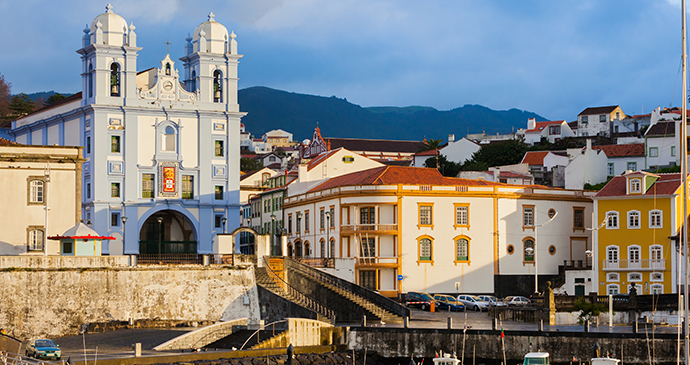
The Duke of Cumberland’s flotilla of English corsairs sank the Spanish galleon Nuestra-Señora de Guia off Terceira in 1589, an example of just one of almost 900 ships recorded lost from various causes in the Azores in the past 500 years. In the Bay of Angra alone there are some 80 shipwrecks, the deepest lying in 60m of water, the oldest from 1543. Angra provided the safest haven but, when storms blew in from the southeast, it became a dangerous dead end and disastrous for those ships too slow or unable to leave in time.
It seems there are few doubloons to be found because any treasure was recovered soon after the shipwreck since such losses would severely impact upon the Portuguese and Spanish economies. These wrecks, however, represent the most marvellous sites of marine archaeology, time capsules because of the suddenness of their demise. There is also an ‘anchor graveyard’ near Angra, created by ships cutting their anchors in a hurry to avoid rough weather.
Although no-one wants to live in a theme park, what a stimulating centre Angra could become for the study and interpretation of a most exciting and vivid period of history. The exploration, exploitation and colonial expansion of new lands and the maritime consequences of politics and war on mainland Europe could become a major visitor site like the one at Faial’s Capelinhos.
Corvo, Flores and Graciosa
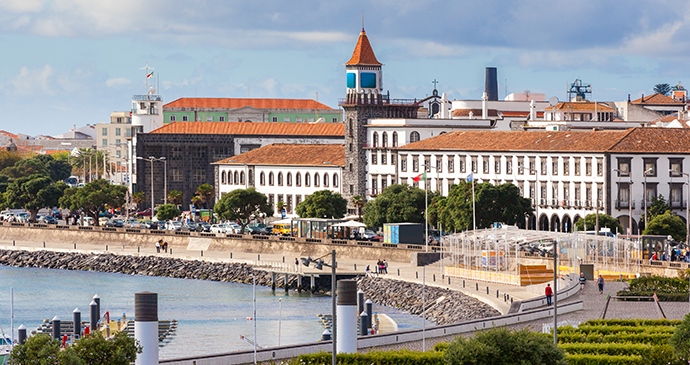
Flores
For many visitors, certainly for those seeking nature and tranquillity, Flores will be their favourite island. Not only have you now reached the westernmost island of the archipelago, you are also at the western extremity of Europe. Europe ends at Flores, the Isle of Flowers, on longitude 31° 15’ W, and 2,220km from Lisbon. Given the island’s small area, only 17km long and 12.5km wide, it is probably the most intensively rugged of the archipelago, with peaks, valleys, crater lakes, waterfalls and precipitous cliffs. Small pastures and arable fields all surrounded with hydrangea hedges or lichen-encrusted stone walls tie these together.
Everywhere the countryside is beautiful, and there is constant temptation to stop the car and quietly take in the atmosphere. For walkers, there is the ultimate in conversation stoppers: walking almost the entire length of Europe’s westernmost coastline (unless you count Greenland). In the calmer weather of summer, one of the finest ways to appreciate the island is to take a boat trip around the coast, part of which you will see anyway if you go to Corvo by sea. For manmade attractions, the two museums in Santa Cruz are the treasures
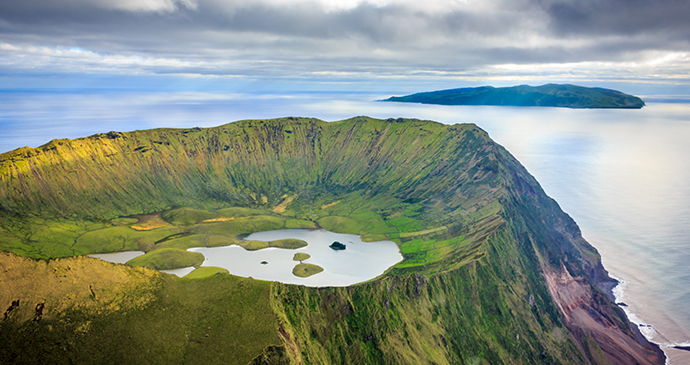
Remote Corvo island may be tiny, but its landscape is truly dramatic © Samuel Domingues, Shutterstock
Corvo
Corvo is by far the remotest island of the archipelago and must surely rate as one of the most isolated places in all Europe. This ancient volcanic remnant is surrounded by an often cruel and savage ocean, and remained inaccessible for months at a time, even from its nearest island neighbour, until the advent of the aeroplane. It is the tiny elusive gem at the apex of the Azores crown. Day visitors from Flores making the boat crossing in settled summer weather account for most of the visitors, but for the true traveller intent upon getting a feel for this island (and for ardent birders who arrive in October looking for American ‘vagrants’), there are a slowly increasing number of accommodation options giving opportunities for longer stays.
On a day visit there should be time enough to walk to the road’s end to enjoy the view down into the crater which, at 300m deep and 2km across, is among the largest in the Azores. However, be warned: it is often shrouded in cloud. For those with more time, there are two official walks to do, and the island is an Azorean highpoint for autumn birdwatching. But the greatest delight must surely come from simply being on Corvo and freeing your senses to absorb its atmosphere of truly splendid isolation.
Graciosa
The general opinion is that Graciosa, meaning ‘gracious’, is the most relaxed of all the islands. Most certainly it would make for a great escape from the mainstream, a place to stay if ever strife and tribulation became too great to handle. Perhaps there has been little change, or at least slow changes in the past few decades. A roughly oval-shaped island lying southeast/northwest and the least humid island of the archipelago, Graciosa’s highest point is Pico Timão at only 398m. As a result, villages are distributed more or less equally across the countryside, and not located only around the coast – very different from some of its fellow islands. The pace is slow, men can still occasionally be seen travelling in pony traps or riding donkeys along the roads, there are at last some good restaurants, the walking is easy and everyone recognises the visitor second time round. The scenery is picturesque, an idyll of pastures and neatly walled enclosures, little clusters of whitewashed houses – with their peculiarly shaped chimneys – around village churches, occasional windmills with their distinctive red, onion-shaped domes (there were once 36) and all surrounded by a glittering blue sea. Like rare wine, it is an island to be enjoyed slowly. It is also, perhaps, a window into what the world could be like with fewer inhabitants.
Of greatest interest is the Furna do Enxofre, the cavern at the bottom of the caldera, first seriously explored in 1879 by Prince Albert of Monaco. The excellent, modern museum in Santa Cruz is worth your time. Otherwise, just relax and enjoy being on Graciosa, free from stress.
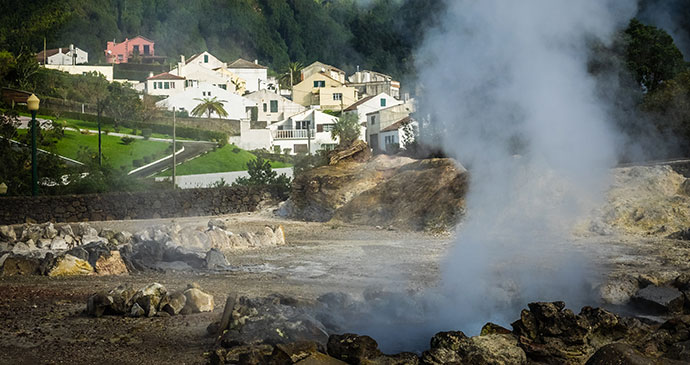
Furnas
In the southeast, the small spa of Furnas, which physically has changed little over the years, is a must. Here, bubbling hot springs and fumaroles, together with the smell of sulphur, remind you that you are on a volcano in spite of the verdant surroundings; in fact you are in the centre of another large crater. Twenty-two mineral waters, all with different tastes, spout out of the ground; some have elaborate manmade ornamental surrounds, while others just flow from between the native heather bushes. The 12ha garden of Furnas’s Terra Nostra Garden Hotel, mostly dating from well over 150 years ago but with beginnings in the late 18th century, with its naturally warm thermal swimming pool and meandering walks beneath some 2,000 trees, provides contact with the genteel life of earlier times.
At the edge of the village is a forest services’ immaculately maintained tree nursery and trout farm; visitors welcome. The local large flat soft rolls called bolos levedos are made in Furnas and are delicious, especially in the Café Atlântico when filled with cheese and ham and toasted.
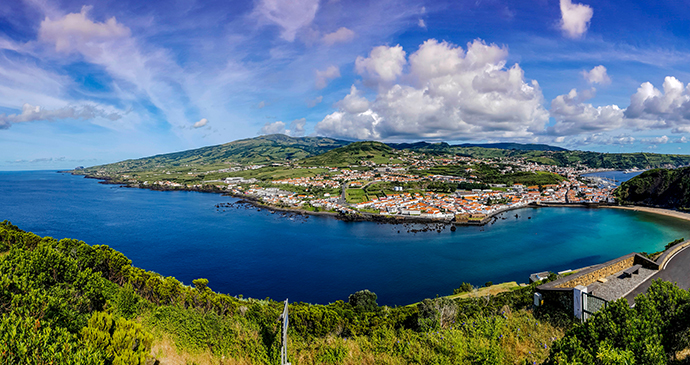
Horta
Picturesque Horta has long been a major port of the Azores and the town has dominated the island; today its marina is a major tourist attraction and the harbour has the largest maritime painting collection in the world. Around 1,100 yachts put in each year for supplies and repairs as they make the Atlantic crossing and this influx of around 5,500 mostly young crew members certainly enlivens the evenings, especially between May and August. History is everywhere among the streets and old buildings, and always across the channel is the great cone of Pico. Sometimes it is totally clear, seeming arrogantly to challenge the elements to renew their erosive attacks. More often, it is adorned with a fast-changing wardrobe of clouds, engulfing its summit, encircling its midriff, or clothing it from apex to base, and obscuring it from our sight but not our consciousness; you never tire of glancing across the channel. In winter with its uppermost quarter dusted with snow and fronted with a travel-brochure blue sea, the mountain is breathtakingly beautiful.
Horta, will take at least a half day to explore, easily a full day with the museums. Seeing the highlights of the rest of the Faial island can be done by taxi or hire car and could occupy a day. There are now a few more official walks too, to stretch the legs.
Praia da Vitória
In contrast with other towns in the archipelago, Praia always feels open and bright. It has an attractive main square and a long pedestrianised shopping street. In winter, it wears the clothes of an out-of-season resort, with slow business at the hotels and restaurants. In summer, its large, artificial beach and sheltered bay attract holidaymakers and the town kicks into life: the major festivals take it to a whole different level again. Seasonal ferries land visitors from other islands here and Praia is also home to the island’s commercial port. The extensive lowlands of this eastern half of the island produced large quantities of wheat, and the wealth created is reflected in many fine houses in the town. At first called simply Praia, it gained town status in 1640. In 1581, after bombarding Angra, a Spanish fleet of ten ships was reconnoitring the Terceira coast and anchored in Salga Bay, in the southeastern corner. They were seen and the alarm given but by the time the Portuguese arrived 1,000 Castillians had landed and were already bent on destruction. After a morning’s fierce but indecisive fighting an Augustinian friar had the idea to drive cattle at the enemy. Over 1,000 animals were stampeded at the Spaniards, who fell back in disarray and were either killed or drowned on the shore. Thus ended the Battle of Salga. Again battle came to Praia in 1829, when the town, supporting the Liberal cause, successfully resisted an attempted landing by an Absolutist fleet of 21 ships. In commemoration, the town was called Praia da Vitória in 1837. The nearby Lajes airport now covers much of what were the great wheatfields of earlier days.
In the main square, the Praça Francisco Ornelas da Câmara, is the Liberty Statue, erected on the centenary of the 1829 battle won by the Liberals in homage to the heroes. Overlooking the square is the attractive town hall, and further along on the Rua de São Paulo is the parish church, the Santa Cruz church. This was founded by one of the first settlers and has a 15th-century Gothic doorway and a 16th-century Manueline side doorway. Inside there are fine carvings, rich giltornamentation and various works of art. Further along on the same road, on the left, is the house where the writer Vitorino Nemésio (1901–78) was born. He held several senior academic posts in Lisbon and was a novelist, poet and scholar and also a popular television personality; his novel of 19th-century life on Faial and Pico, Stormy Seas, is in English translation.
In the opposite direction, towards the far end of the main pedestrianised Rua de Jesus, is the town market, built in the final quarter of the 19th century. Alternatively, in the opposite direction, take the Rua da Alfândega which becomes Avenida Álvaro Martins Homem and leads down to the beach and along to the modern marina.
The reduced strategic importance of Lajes airport has had an effect on the town, with the number of US military personnel reduced from 2,500 to fewer than 200. For a small town like Praia, that is a significant dent to the economy. New direct flights from Boston and Madrid have helped to alleviate the damage, and the promise of budget flights from the Portuguese mainland will provide further stimulus.
Santa Maria
Santa Maria sees itself as the sun island. Its claims that, being a little further south and east than all the other islands, it receives more sunshine and enjoys higher sea temperatures – and these are indeed borne out by statistics. Sheep graze the flatlands around the airport, an area with virtually no trees, but this scenery changes rapidly on the approach to the central peak of Pico Alto, the island’s highest point at 590m. Here once again is the typically lush Azorean green forest with cryptomeria trees and pittosporum, mixed in places with native shrubs. Then comes the eastern half and its idyllic, picturesque, tranquil, verdant landscapes of woodland and pastures. These may be sprinkled with glimmering white traditional houses that are scattered, either in little clusters or in small villages. In places there are no buildings at all, or perhaps just a time-weathered basalt shelter tucked away in a corner of a field. There are dramatic coastlines, proud headlands and sheltered bays, and a novelty for the Azores: white sand. This island supplies the potters on São Miguel with some of their clay, and from deposits at Santana and Figueral came the lime to whitewash all the archipelago’s houses.
Serious hikers can now spend a few days doing the Santa Maria circular walk. For drivers, to hire a car and meander along almost empty winding roads through such glorious countryside, stopping for views and parking the car at the end of a farm road and just exploring to the sound of birdsong, makes for a wonderful three or four days’ holiday. High sea cliffs provide precipitous views and you can drop down to the coast at Maia and São Lourenço for sea swimming in manmade pools with their own natural wave machine. Between exploring the varied environments you have the white sandy beach at Praia Formosa (though it disappears in the winter waves), and the sea pools at Anjos in which to relax. Other places of interest include the little chapel at Anjos associated with Columbus’s first landfall on his return from the Americas and the quite remarkable stone terraced vineyards at Maia, an extraordinary work of such great skill and energy you are left wondering at the effort humankind is prepared to make to produce wine! And then there’s the amazing red soils and almost desert landscape of Barreiro da Faneca, not forgetting that, in keeping with its status as the oldest Azore, this is the only island in the archipelago where you can find fossils.
São Jorge
An islander used to greet visitors with ‘Welcome to São Jorge, my island with around 9,000 people and over 20,000 cattle’. Known widely beyond its shores for its delicious, strong, Cheddar-like cheese, the other attributes of this long, cigarshaped island are far less recognised. To some, São Jorge is an island of mystery, sometimes disappearing into cloud or mist. Arriving at the Velas quay, the imposing sea gateway and walls dating from the time of pirates promise quiet pleasure. Velas town itself features narrow streets, small shops, an impressive church, some manor houses, a little square or two and the sound of voices drifting out from tiny bars.
Elsewhere, there is an intense pleasure to be derived from walking along little used farm roads in utter silence with stone walls, hedgerows, cows and occasional trees giving depth to the stage. In sunshine and with a deep-blue sea beyond, the cliff paths are magnificent for scenery, combining landscape grandeur and intimate vignettes together with unexpected human interest, while steep descents to isolated fajãs on tiny tracks give a tender appreciation of the hardships of the islanders.
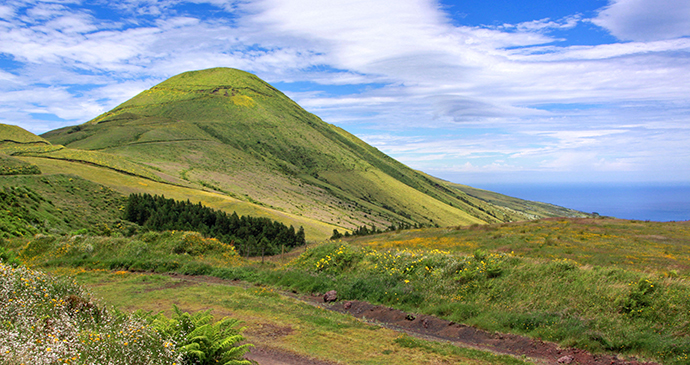
Although it is an island with good walks, graded unsurfaced roads have in recent years ramified throughout the island and in reasonable weather allow the motorist to explore many of the previously hidden beauties of the island. Many very happy days can be had exploring the island back roads as well as the little-trafficked main roads from which side roads lead into small, often charming villages.
On a full moon the island comes into its own; the channel across to Pico island reflects and shimmers, while the great black unequal-sided triangle of Pico mountain massively provides the theatre setting. In Velas, drop down to the harbour, and on the tiny terrace, if you are lucky, thrill to the haunting mew of Cory’s shearwaters as they fly just above your head in the dark.
By car, São Jorge is an island on which to spend slow days relaxing, stopping to explore the accessible little settlements along the coast – or walking to the more isolated ones – and pausing to enjoy the scenery. On the southern coast, it can be difficult to tear your eyes away from the imposing pinnacle Pico. The fajãs, while not unique to São Jorge, are a very special feature of this island.
Now classified as a UNESCO Biosphere Reserve, their microclimates and settlements are most rewarding to explore – some are only accessible on foot. There are numerous viewpoints, the two ports of Velas and Calheta, lovely sites for picnics, and opportunities to make easy short walks – there are plenty to take you to lovely places. One can also take the ferry and visit Pico and Faial islands, the other two islands that make up the so-called triangulo.
Sete Cidades
Mythology provides a romantic history. Once long ago in the kingdom of the Seven Cities, there was a king. He had a very pretty daughter who loved the countryside and happily roamed the fields, the little valleys and the surrounding hills. One day she came across a handsome shepherd boy tending his animals, and they shyly spoke. As the days went by she saw him again, and then again, and slowly romance blossomed and they fell deeply in love. Unfortunately, her father came to hear of this romance and was furious, because he intended his daughter to marry a neighbouring prince who was heir to a large kingdom. He forbade his daughter ever to see her shepherd boy again, but she pleaded so well that he agreed they could meet for one last time. At the final parting, they both cried so much two lakes were formed, one blue from the princess’s eyes, the other green from those of the shepherd boy, and although they were parted forever, their tears have remained united.
Inevitably you will stop at the main viewpoint, the Vista do Rei, named from King Carlos’s visit in 1901, where you can see both lakes of tears. The circumference of the caldera is roughly 12km.
The raffish traveller Thomas Ashe, describing his travels on São Miguel in 1813, wrote that the banks were planted with hemp or flax, which was cured in the lakes. There were only half a dozen houses in the valley where the hemp growers lived, and manufacturing was done by the village of Bretanha and neighbouring villages; some 50,000 yards was used domestically and more for export. The surrounding hillsides with their trees in little groves and bowers and the long winding valleys ‘made them pre-eminently beautiful, and particularly favourable for romantic leisure and tender passions’.
Related books
For more information, see our guide to the Azores:
Related articles
Marble caves, salt lakes and rainbow mountains.
A soothing spa among dramatic landscapes, what could be better?
